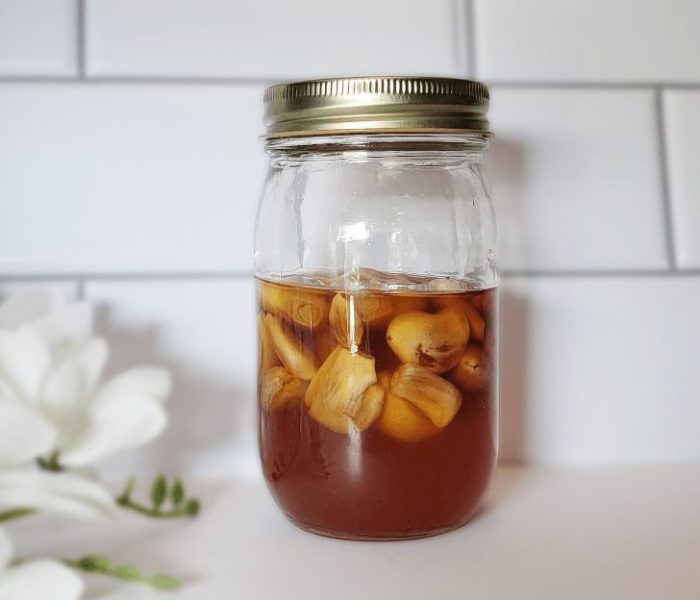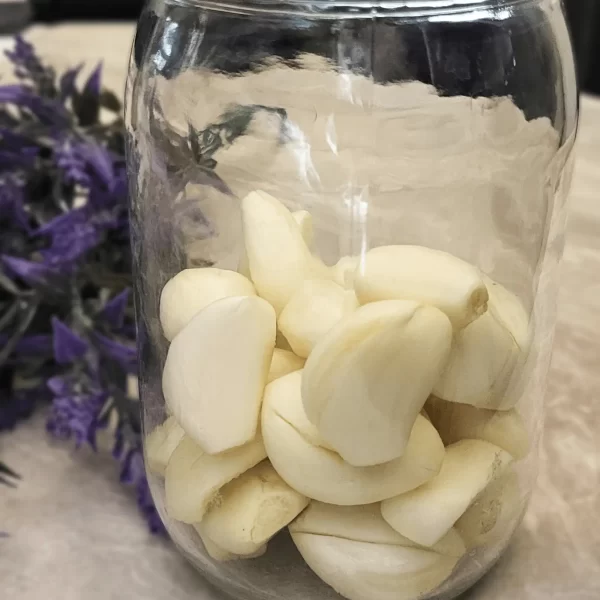Fermented garlic honey is a healthy, delicious, and easy-to-make ferment you’ll want to add to your pantry this season. In this post, I will teach you how to quickly and easily ferment garlic in honey, and also touch on its numerous benefits.

What is Fermented Garlic Honey?
It is simply raw garlic cloves mixed with raw unfiltered honey, fermented for approximately 4 weeks. Both garlic and honey individually have potential nutritional benefits, and combining them through fermentation can enhance those benefits.
The fermentation process gives it a deep umami flavor. The garlic becomes sweetened and tangy, and is much milder than fresh garlic. The honey becomes syrupy and sweet, with a mild garlicky flavor.
I usually use it over toasts, cheeses, meats, veggies, or in a dressing.
Benefits of Fermented Garlic Honey
As seen in this study, raw honey is rich in antioxidants, has antiviral, antibacterial, and anti-inflammatory properties, and is known to help boost the immune system.
Garlic also offers many benefits including reducing inflammation, acting as an antioxidant, and supporting heart and digestive health, as seen in this study.
During fermentation, the natural yeasts and good bacteria in the raw honey break down sugars and create a more probiotic-rich environment.


How To Make Fermented Garlic Honey
Equipment:
- Glass jar with lid
Ingredients:
- Garlic cloves
- Raw unfiltered honey
1. Prepare garlic
First, you’ll want to prepare the garlic by removing the peels. I usually place the individual cloves on my counter and use a large knife – or a wooden cutting board – to gently press down on the cloves so the skins peel off easier. Try keeping the cloves whole; you don’t want to completely crush the garlic, but slightly crushed or cracked garlic cloves are perfect, because the juices from the garlic will get the fermentation process going quicker. As for how much garlic to use, this depends on the size of jar you plan on using. The rule of thumb usually is to fill the jar half way up with garlic cloves.

2. Add honey
Next, you’ll add the raw, unfiltered honey. Pour enough to cover the garlic cloves. We use raw honey to make fermented garlic honey because it is taken directly from the hive without any pasteurization (heating) or filtration. It has the highest amount of pollen and nutritional compounds that are necessary for fermentation. Additionally, it has a pH ideal for preventing botulism.
3. Let fermentation begin
Now we let the fermentation begin. Close the lid on your jar loosely and place it in a cool, dark location like a cabinet or a pantry. The lid should be loose so the natural gasses can escape. Since the garlic will settle at the top, tighten the lid and flip it upside down for a few minutes every day. This is to make sure the honey coats all of the garlic cloves. When done, place the jar right side up and loosen the lid again. Try to do this once or twice a day, if possible.

After a few days to a week, you will notice bubbles forming in the honey, which is totally normal and a great sign that the fermentation magic is happening! Over the next 2-4 weeks the honey will become thinner and runnier due to the liquid in the garlic mixing in with the honey. You now have your concoction of liquid gold. Store it in your pantry or a cabinet for long-term use.

How To Use Fermented Garlic Honey
You can mince or chop the garlic and use it in salads, as a garnish for meats, in sauces, or in dressings. You can even eat one or two cloves right from the jar.
The honey can be mixed into a dressing, drizzled over toast, chicken, fish, or your favorite cheeses. Just try not to heat the garlic or the honey, as heat can destroy some of its beneficial properties.
Frequently Asked Questions
This is a normal process of the garlic and the honey separating.
Fermented garlic honey can be stored for a year, or longer.
After about 4 weeks, once you no longer see bubbles forming at the top.
Botulism can develop in an acidity above pH 4.6, but most raw honey has a pH of around 3.9, which makes consumption safe. If you have concerns, feel free to use a pH test strip. Botulism spores aren't able to reproduce when pH levels are under 4.6.
The blue/green color on the garlic is normal. Garlic has many sulfur compounds and an enzyme called Allenase. When it is added to honey or other acids like vinegar, a reaction occurs and the garlic changes color. It is still safe to consume. The garlic is more likely to turn brown, which is also normal.
Disclaimer:
This post is for informational purposes only and is not intended as medical advice. Always consult with a healthcare professional before making any significant changes to your diet, especially if you have existing health conditions.
Other Fermented Recipes you Might Like

Fermented Garlic Honey Recipe
Equipment
- 12 oz Glass jar with lid
Ingredients
- 1 cup whole, peeled garlic cloves
- 1 cup raw unfiltered honey
Instructions
- Remove the peels from the garlic. Try keeping the cloves whole; you don't want to completely crush the garlic, but slightly crushed or cracked cloves are perfect because the juices from the garlic will get the fermentation process going quicker. You can also poke the cloves with your knife.
- Place the garlic cloves into the jar.
- Pour honey over the garlic cloves until they are completely submerged.
- Close the lid of your jar loosely and place it in a cool, dark location like a cabinet or a pantry. Note: if you prefer to keep the lid tightened, you will need to "burp" the jar every 1-2 days, which means opening the lid to let the natural gasses out, and then closing it back up.
- Since the garlic will naturally settle at the top, flip the jar upside down for a few minutes every day (make sure the lid is tight first). This ensures the honey coats all of the garlic cloves. When done, place the jar right side up and loosen the lid again.
- After about 1 week, you will notice bubbles forming in the honey, which is a great sign that the fermentation magic is happening. After about 4 weeks, once you no longer see bubbles forming at the top, you can tighten the lid and store the jar in a cabinet or pantry for long-term use.
Notes
- Garlic honey should not be given to babies under 1 year of age.
- Fermented garlic honey can be stored for a year or longer at room temperature.
- Use raw unfiltered honey because it has the highest amount of pollen and nutritional compounds necessary for fermentation. It also has a pH ideal for preventing botulism.
- Do not reuse the honey to make new garlic honey ferments. Start each new batch using fresh honey. The same rule applies to the garlic; do not reuse the garlic to start new ferments.
- Do not add more honey to the jar after it has been fermented. It is best, and safest, to start a new batch.




